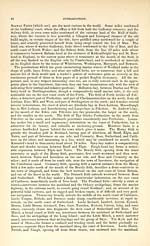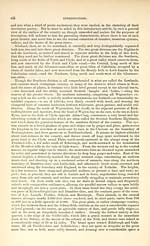Download files
Complete book:
Individual page:
Thumbnail gallery: Grid view | List view

INTRODUCTION. VU
The sound of Mull, a narrow strait, extends south-eastward between Morvern in Argyle-
shire and the island of Mull. Loch-Linnhe, a large and long sound, stretches north and
south between Lorn in Argyleshire and the island of Mull ; and is thickly sprinkled
with islands and islets belonging to the Mull group of the Hebrides. Lochs Eil, Leven,
Crinan, and Etive branch away from it, and run far into the interior, — the first leading
the way from the west to the navigation of the Caledonian canal. The sound of Jura,
extending north and south, intervenes between the district of Knapdale and the island
of Jura ; and the sound of Isla, extending in the same direction, forms a narrow stripe
between Jura and Isla. The frith of Clyde, previously to its being ramified into a
lab} T rinth of straits and sound and curiously elongated bays, rolls, in its great gulf of
waters, its little ulterior sea, between the long peninsula of Kintyre on the west and the
coast of Ayrshire on the east ; and, in its higher waters, it encloses the various parts or
islands of Buteshire, cleaves southern Argyleshire into a series of wildly Highland and
singular peninsula?, makes a considerable cleft in Dumbartonshire, and, as to its main
channel, divides the counties of Argyle and Dumbarton from those of Ayr and Renfrew.
Loch- Ryan and Luce-bay invade Wigtonshire on a line with each other, and on opposite
sides, — make such a mutual advance as to leave a comparatively narrow isthmus between
their inner extremities, — and divide the Rhinns of Galloway from the rest of Wigtonshire.
Wigton-bay makes a long inroad between the two great political divisions of Galloway.
Fleet, Kirkcudbright, and Auchencaim bays, and the estuary of the Urr, indent the
coast of Kirkcudbrightshire. The estuary of the Xith divides, for a considerable dis-
tance, the stewartry of Kirkcudbright from the country of Dumfries.
SURFACE.
Hundreds and even thousands of parishes in England so closely or exactly resemble
one another in all their features of landscape, that a sufficiently graphic description of
one might be superscribed successively with the names of all. But so wondrously diver-
sified is the surface of Scotland, that each of all its parishes, except a few, has some
broad distinctive features of its own, each of the great majority might be the subject of
a picture replete with individuality, and each of very many offers to the painter entire
groups, sometimes multitudinous clusters of scenes which are rich in the peculiarities of
their respective elements. Any general description of such a country is in the highest
degree susceptible of colouring from the bias of aversion or of favourable predilection.
Scotland has spots as lusciously lovely, or as superbly magnificent as ever poet sang,
and spots as unutterably dreary or as inhospitably sequestered as ever a dreaming or
misanthropic anchorite conceived ; and, in respect both to scenery and to climate, can
probably exhibit some actual tract of territory to justify, or at least to countenance, on
the one hand, each sneer or sarcasm which has been written against her by illiberal pre-
judice, and, on the other, each of the most impassioned panegyrics which have been
sung upon her by patriotic and enthusiastic admiration. To be fully understood, the
country must be seen or studied in minute detail : no general description of it can be
made the vehicle of very distinct ideas. Only such readers as acquaint themselves with
it through some such medium as a copious Gazetteer, can be said to comprehend it,
— examining it piece by piece in such large districts as those of counties and grand
divisions, and then looking in detail at its parishes, its principal mountains, its lakes,
its rivers, and all its various interesting objects. Whoever shall peruse the present
work, first in the great and comprehensive articles, and next, in the multitudinous briefer
articles which exhibit the individual objects, and describe the minute features of the
grand picture, must rise, we should hope, from the perusal with conceptions of the sur-
face of Scotland incomparably clearer than if he had read any conceivable amount of con-
secutive description. He will be surprised, perhaps bewildered, by the amount of va-
riety ; he will be delighted, or even thrilled, by the frequency with which scenery occurs,
ever new or peculiar, and addressing itself by turns, or in combinations, to every power
of taste, from the love of the calmly beautiful to the sturdiest and sternest capacity for
the awfully sublime ; he will wonder to discover many a fairy nook or striking lusus na-
turce in a district which probably rash satire had pronounced repulsive even to a savage ;
and when he reflects how spiritedly and copiously Wordsworth and Scott, and many
other masters of song, have written upon Scottish landscape, he will conjecture how
mighty an impulse they must have felt, and how resistlessly they were hurried along,
The sound of Mull, a narrow strait, extends south-eastward between Morvern in Argyle-
shire and the island of Mull. Loch-Linnhe, a large and long sound, stretches north and
south between Lorn in Argyleshire and the island of Mull ; and is thickly sprinkled
with islands and islets belonging to the Mull group of the Hebrides. Lochs Eil, Leven,
Crinan, and Etive branch away from it, and run far into the interior, — the first leading
the way from the west to the navigation of the Caledonian canal. The sound of Jura,
extending north and south, intervenes between the district of Knapdale and the island
of Jura ; and the sound of Isla, extending in the same direction, forms a narrow stripe
between Jura and Isla. The frith of Clyde, previously to its being ramified into a
lab} T rinth of straits and sound and curiously elongated bays, rolls, in its great gulf of
waters, its little ulterior sea, between the long peninsula of Kintyre on the west and the
coast of Ayrshire on the east ; and, in its higher waters, it encloses the various parts or
islands of Buteshire, cleaves southern Argyleshire into a series of wildly Highland and
singular peninsula?, makes a considerable cleft in Dumbartonshire, and, as to its main
channel, divides the counties of Argyle and Dumbarton from those of Ayr and Renfrew.
Loch- Ryan and Luce-bay invade Wigtonshire on a line with each other, and on opposite
sides, — make such a mutual advance as to leave a comparatively narrow isthmus between
their inner extremities, — and divide the Rhinns of Galloway from the rest of Wigtonshire.
Wigton-bay makes a long inroad between the two great political divisions of Galloway.
Fleet, Kirkcudbright, and Auchencaim bays, and the estuary of the Urr, indent the
coast of Kirkcudbrightshire. The estuary of the Xith divides, for a considerable dis-
tance, the stewartry of Kirkcudbright from the country of Dumfries.
SURFACE.
Hundreds and even thousands of parishes in England so closely or exactly resemble
one another in all their features of landscape, that a sufficiently graphic description of
one might be superscribed successively with the names of all. But so wondrously diver-
sified is the surface of Scotland, that each of all its parishes, except a few, has some
broad distinctive features of its own, each of the great majority might be the subject of
a picture replete with individuality, and each of very many offers to the painter entire
groups, sometimes multitudinous clusters of scenes which are rich in the peculiarities of
their respective elements. Any general description of such a country is in the highest
degree susceptible of colouring from the bias of aversion or of favourable predilection.
Scotland has spots as lusciously lovely, or as superbly magnificent as ever poet sang,
and spots as unutterably dreary or as inhospitably sequestered as ever a dreaming or
misanthropic anchorite conceived ; and, in respect both to scenery and to climate, can
probably exhibit some actual tract of territory to justify, or at least to countenance, on
the one hand, each sneer or sarcasm which has been written against her by illiberal pre-
judice, and, on the other, each of the most impassioned panegyrics which have been
sung upon her by patriotic and enthusiastic admiration. To be fully understood, the
country must be seen or studied in minute detail : no general description of it can be
made the vehicle of very distinct ideas. Only such readers as acquaint themselves with
it through some such medium as a copious Gazetteer, can be said to comprehend it,
— examining it piece by piece in such large districts as those of counties and grand
divisions, and then looking in detail at its parishes, its principal mountains, its lakes,
its rivers, and all its various interesting objects. Whoever shall peruse the present
work, first in the great and comprehensive articles, and next, in the multitudinous briefer
articles which exhibit the individual objects, and describe the minute features of the
grand picture, must rise, we should hope, from the perusal with conceptions of the sur-
face of Scotland incomparably clearer than if he had read any conceivable amount of con-
secutive description. He will be surprised, perhaps bewildered, by the amount of va-
riety ; he will be delighted, or even thrilled, by the frequency with which scenery occurs,
ever new or peculiar, and addressing itself by turns, or in combinations, to every power
of taste, from the love of the calmly beautiful to the sturdiest and sternest capacity for
the awfully sublime ; he will wonder to discover many a fairy nook or striking lusus na-
turce in a district which probably rash satire had pronounced repulsive even to a savage ;
and when he reflects how spiritedly and copiously Wordsworth and Scott, and many
other masters of song, have written upon Scottish landscape, he will conjecture how
mighty an impulse they must have felt, and how resistlessly they were hurried along,
Set display mode to: Large image | Transcription
Images and transcriptions on this page, including medium image downloads, may be used under the Creative Commons Attribution 4.0 International Licence unless otherwise stated. ![]()
| Gazetteers of Scotland, 1803-1901 > Topographical, statistical, and historical gazetteer of Scotland > Volume 1 > (19) Page vii |
|---|
| Permanent URL | https://digital.nls.uk/97437774 |
|---|
| Description | Volume first. A-H. |
|---|---|
| Attribution and copyright: |
|

